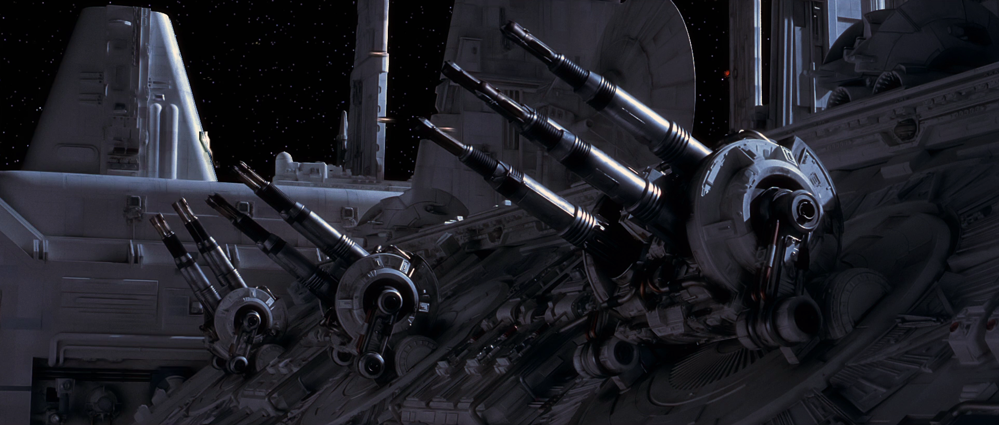Directorate Officer

Image Source: here (Star Wars Episode 1)
Intent: to provide an updated version of the small quad turbolasers used on Victory-class Star Destroyers and the original Dreadnaughts
Development Thread: If needed
Manufacturer: Lucerne Labs
Model: LLT-8 Triumph-class Light Quad Turbolaser
Affiliation: Open Market (With Marketplace Purchase)
Modularity: No
Production: Mass
Material: typical turbolaser components: primary laser, actuator, galven coils, capacitor banks, heat sinks, cyro-cooling barrel sleeves, energization crystals, etc.
Classification: Ship to Ship Turbolaser
Size: Capital ship scale
Length: 6 meters
Weight: 20 tons
Ammunition Type: blaster gas, energy
Ammunition Capacity: dependent on carrier vessel
Effective Range: same as standard turbolaser
Rate of Fire: Varies (see firing modes below for more detailed information)
Special Features:
-Three firing modes (low, medium, high)
-Three Firing patterns (one-two punch, one-two continual, Quad Fire-linked)
Strengths
-higher rate of fire compared to standard turbolasers
-Better tracking on smaller targets because of shorter barrel length and less overall mass
-Multiple fire modes and patterns
Weaknesses
-individual turbolaser bolts are much weaker than standard turbolaser bolts
-Lesser damage output over a comparable amount of time compared to standard turbolasers
Description:
The LLT-8 Triumph-class Light Quad Turbolaser is an updated version of the quad turbolasers used on the Victory Mk I-class Star Destroyers introduced during the Clone Wars. Unlike most current quad turbolasers, the Triumph is significantly smaller, actually a quad mounting of four light turbolasers. In terms of energy use and size, it is equivalent to a standard turbolaser. However, in terms of overall damage, the LLT-8 actually produces less damage compared to conventional turbolasers in order to make it a better multi-purpose weapon. Most of this is due to the barrel’s smaller size and mass, making it quicker to track targets at the cost of making it a less powerful weapon, but many of its strengths are inherited from another ancestor, the DBY-827 Dual Turbolaser.
The core design of each of the Triumph’s light turbolasers is a much scaled down version of the DBY-827 Dual Turbolasers. Whereas the 827 had seven different intensity settings, the Triump has only three, because its smaller size does not allow as much power to run through it compared to its parent design. On its highest intensity, the combined salvo of four bolts is roughly equivalent to 80% of a standard turbolaser bolt. Its middle setting fire twice as quickly, but each bolt is half as strong as the previous bolts (about 1/8 as powerful as a standard turbolaser bolt). On its lowest intensity setting, individual bolts are equivalent to heavy laser cannons, but at a much higher rate of fire, making it well-suited against smaller ships such as freighters or starfighters flying in formation.
These intensity settings are then combined with the three original firing patterns that the DBY-827 used, except adapted for firing four guns rather than two.
The first is called the “one-two punch firing pattern”, where the turbolasers are fired in staggered pairs. Ideally, the first pair of shots would knock out the target’s defenses, such as shielding or hull plating, allowing the second pair of bolts to hit the target itself. Because of the low power of the Triumph itself, this mode rarely works by itself as planned except on corvettes and smaller ships, though it is often used effectively in conjunction with other weapons in a barrage on larger vessels. Typically this mode is used with the highest fire setting to knock and destroy the subsystems on larger ships such as opposing turbolaser batteries.
The second is the “one-two continual firing pattern”, which typically uses the medium and low fire intensity to produce almost incessant barrage of bolts to act as “flak” against swarms of smaller ships. The lowest firing intensity is typically used against starfighters, where it appears to almost be a continuous stream of fire (hence the name). The medium firing intensity is used against ships larger than starfighters but smaller than corvettes. The continual firing pattern cannot be used with the highest firing intensity because it would overheat the cannons and melt them.
The final firing pattern, “Quad fire-linked”, all of the turbolasers are fired simultaneously at the cost of a lower rate of fire. While it can be used with any fire intensity, it is typically combined with the highest fire intensity where the bolts can impact areas almost simultaneously to punch through shields via brute force or incinerate small targets.
The LLT-8 Triumph also incorporates advances in turbolaser targeting technology not available in the Clone Wars, but which are now more common, including the use of antenna locking, in-line calibration and helical-motion extrapolators. All of these fire control technologies were originally pioneered on the ISD Judicator. These fire control opponents help the Triumph effectively track and target smaller enemy ships.
Because of their lesser overall destructive power compared to typical turbolasers, Lucerne Labs anticipates these turbolasers as being used as ancillary weapons to the main armament. Its jack of all trade nature, while not being especially effective against either capital ships or starfighters, grants its user some flexibility in the way it engages threats.












